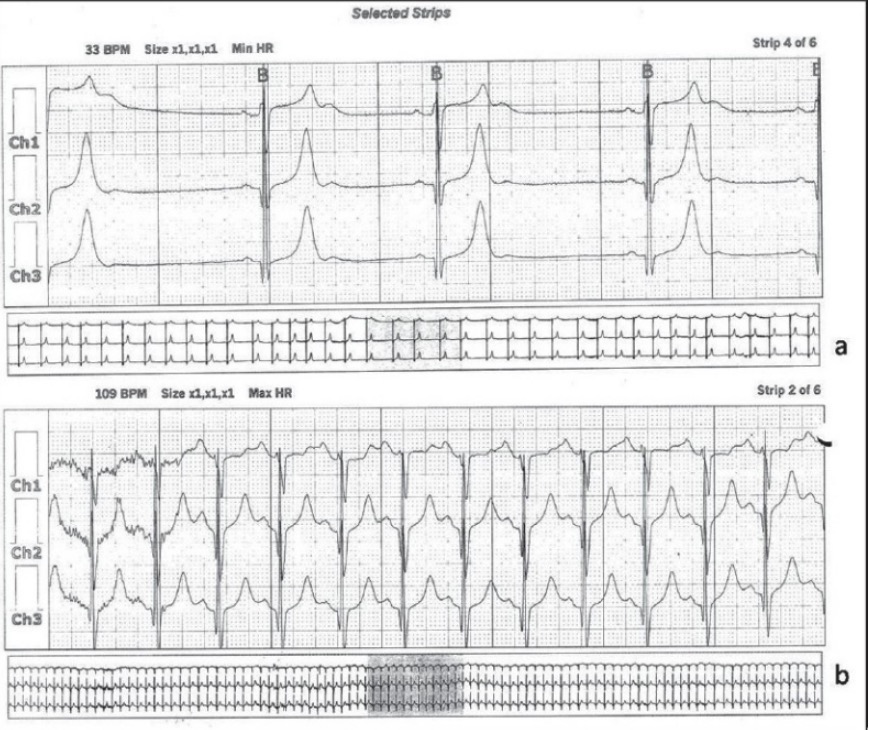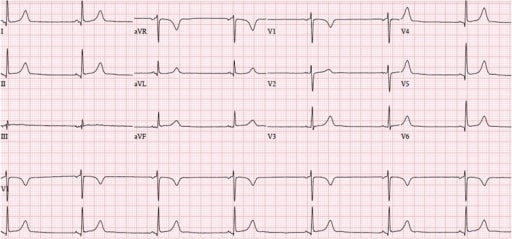Playlist
Show Playlist
Hide Playlist
Sick Sinus Syndrome and Sinus Exit Block
-
Slides Heart Blocks.pdf
-
Download Lecture Overview
00:01 Hello. And welcome back to the EKG course or ECG course depending upon which abbreviation you prefer. 00:08 Today, we're going to talk about electrical blocks in the electrical system of the heart that can be benign or it can be life-threatening. 00:18 And I will take you through the whole spectrum of heart blocks from minor to much more severe. 00:24 So, when heart block occurs, there is a malfunction in the electrical system leading usually to a drop or missed beat on the ECG or multiple dropped or missed beats. 00:35 So, let's start in the first area in the sinus node. 00:39 I mentioned in one of the last lectures that the sinus node can be diseased just like the rest of the conduction system can be diseased. 00:47 And when that happens, often, beats fail to emerge from the sinus node. 00:52 And often that's called sick sinus syndrome; SSS. 00:56 And in that situation, you may have at times very slow action by the sinus node and intermittently, one may have breakaway - rapid arrhythmias and it's called brady/tachy, the word bradycardia, means slow heart rate. 01:12 And the word tachycardia means fast heart rate. 01:16 And often that's treated with drugs and with a pacemaker. 01:21 Now, what happens when the blockage in the cardiac electrical system is lowered down? So, if it's in a sinus node, this can be a minor problem or you can have the brady/tachy syndrome where you need drugs and a pacemaker. 01:36 But usually, most blocks are not so much in the sinus node, but they're lower down in the AV node. 01:44 And when the disease in the AV node become severe, beats may not get through to the ventricle. 01:51 You may have a very slow heart rate and again, pacemaker therapy may be required. 01:55 And we're gonna go over that in more detail. 01:57 Sometimes the block is even below the AV node and that can result also in very severe slow heart rates because no impulses are getting through to the ventricle. 02:07 So, heart block below the AV node as I said, often results in a very slow heart rate and requires a pacemaker therapy. 02:16 Sometimes these patients will have heart rates as low as 20, and of course that results in a very low blood pressure and people can faint. 02:24 And eventually, if you don't put a pacemaker then it will be fatal. 02:27 So, let's start with some examples. We'll start with a sinus node. 02:32 So, here's an example of a sinus node block. Let's follow through the rhythm strip. 02:38 The first complex has a P-wave, a QRS and a T wave. 02:43 The next complex has a P wave, a QRS and a T wave. 02:47 And then in the area of the green box, we're missing a P-wave. And then the rhythm resets again. 02:52 You'll notice when it resets that the P-wave in the resetting, first beat after the green box is slightly abnormal which means the impulse is coming either slightly to the right or left to the sinus node or nearby or else emerges abnormally from the sinus node but then it resets itself normally. 03:11 You'll see the last complex PQRS and T is just like the beginning ones. 03:15 Now, so, the P-wave was absent due to an abnormal sinus node function. 03:22 And in this case, we call it a sinus exit block. 03:26 That is the electrical impulse failed to come out of the sinus node. 03:30 And usually, an occasional single dropped beat like this is not symptomatic and is not serious except it warns the clinician that the patient has abnormalities in sinus node function. 03:44 So, again, I point out that the unusually shaped P-wave on the next beat after the green box, the one in the black box is an atrial escape beat. 03:55 It's not from - directly from the sinus node or it's emerging abnormally from the sinus node which is why it looks a little different from the other P waves. 04:03 Eventually, the sinus node resets itself and subsequent P waves in the rhythm are normal.
About the Lecture
The lecture Sick Sinus Syndrome and Sinus Exit Block by Joseph Alpert, MD is from the course Electrocardiogram (ECG) Interpretation. It contains the following chapters:
- Sick Sinus Syndrome
- Sinus Node Block / Sinus Exit Block
Included Quiz Questions
Where do most heart blocks occur?
- AV node
- SA node
- Purkinje fibers
- His fibers
- Bundle of Kent
Which of the following best describes a sinus exit block?
- Failure of the electrical impulse to leave the sinus node
- Abnormally fast accessory conduction pathway from the atria to ventricles that bypasses the AV node
- P waves and QRS complexes that are not rhythmically associated
- The progressive lengthening of the PR interval until a beat is dropped
- Dropped beats that are not preceded by a change in the length of the PR interval
Customer reviews
5,0 of 5 stars
| 5 Stars |
|
5 |
| 4 Stars |
|
0 |
| 3 Stars |
|
0 |
| 2 Stars |
|
0 |
| 1 Star |
|
0 |





